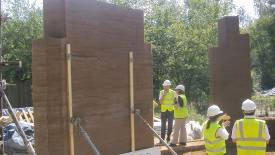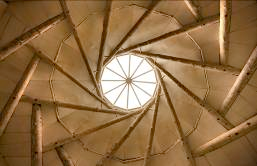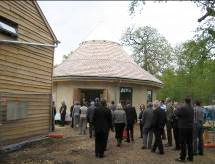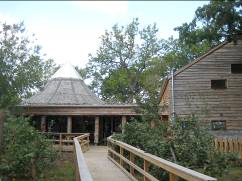Putting research into practice in the design of low carbon buildings
Submitting Institution
University of LincolnUnit of Assessment
Architecture, Built Environment and PlanningSummary Impact Type
SocietalResearch Subject Area(s)
Built Environment and Design: Building, Other Built Environment and Design
Summary of the impact
It is widely acknowledged that conventional approaches to planning and
development exacerbate
environmental problems with consequential negative social and economic
impacts. This award
winning research proposes alternatives by examining the systems and
techniques used in the
design of autonomous eco-building in order to identify best practice in
the procurement of low
carbon buildings. The research findings were first tested and subsequently
validated, through the
design and construction of a community building in Lincolnshire. This
building has won multiple
awards for innovations in sustainability and the underpinning research has
impacted at regional,
national and international level through direct application to design,
changes to professional
practice and through enhanced public awareness
Underpinning research
The underpinning research began in 2005 through an externally funded
Knowledge Transfer
Partnership project (KTP) and is ongoing. Its quality is such that it was
rated as being "outstanding"
on completion in 2007. In 2009, the research was awarded the national
award for the Best
Application of Social or Management Science by the Knowledge Transfer
Partnerships
programmes. In addition, the Community Building itself is a recipient of
the Lord Stafford Award for
Innovation for Sustainability (2009) and the Green Apple Award for the
Built Environment and
Architectural Heritage (2009). In 2011, the building won the Sustain Award
for Construction given
by Sustain Magazine.
2.1 Context of the research: The construction industry is a major
contributor to climate change,
as it is responsible for almost half of the global greenhouse gases and
consumes 40% of the
materials entering the global economy. In response to the challenge of
climate change, the UK
has introduced new stringent codes and standards in order to reduce the
energy consumption of
buildings and to make them carbon neutral in future. The debates around
sustainability are
becoming increasingly sophisticated and there is recognition that
considering environmental
sustainability alone, without considering broader economic and social
contexts, is likely to frustrate
any attempts to achieve realistic levels of sustainable development.
2.2 Current research gaps and how this research addresses them:
Although the construction
industry is gradually moving towards more sustainable practices due to a
range of regulatory and
voluntary initiatives, there are both gaps in knowledge and shortcomings
in current practice that
need to be addressed. Crucially, a holistic approach to sustainability
that ensures that all
stakeholders work together towards common goals is missing. This research
supports the thesis
that such a holistic approach can be achieved only by addressing the
social, economic and
environmental aspects of sustainability simultaneously. It emphasizes the
necessity of the
collaboration of all stakeholders to quantify and interpret environmental
impacts of buildings
throughout the building lifecycle as a key indicator of responsible use of
resources and energy, and
offers an exemplar of this philosophy in practice. Among the main
objectives of the research are;
- To identify the drivers for sustainability
- To identify the content for sustainable buildings
- To identify the process for development of sustainable buildings.
2.3 Research methodology: This research has used an inductive
research methodology in order
to understand the factors influencing sustainability in the built
environment. This "Action Research"
approach is common in design-based applied disciplines as it is close to
the iterative approach
used in the design of buildings. The literature review has centred on
sustainability, life cycle
analysis and legislation in the UK.
2.4 Key research findings: The research findings are diverse and
address aspects of both
planning and development. In addition to the purely theoretical, the
research findings were also
applied and validated through the design and construction of an award
winning building project.
(See section 4). Among the research findings are:
- That a balanced view should be sought to address all aspects of
sustainability including social,
economic and environmental.
- That focusing on driving down operational impacts alone is inadequate
as this ignores both the
increasingly important, in percentage terms, initial and end of life
impacts of buildings.
- That in order to ensure a truly sustainable building, the construction
industry must support the
provision of robust data and facilitate design teams in accessing it to
inform decision making in
the design process.
- That a collective approach should be sought involving all stakeholders
and actors from early
stages of building procurement to ensure the attainment of sustainable
buildings.
- That the establishment of a comparative market in CO2
emissions that enables comparisons
between different stakeholders to be made will help to drive down the
impact of the industry as a
whole.
2.5 Research team: The research that underpins this case study is
ongoing work which was
originally initiated as part of a two year (2005-07) Knowledge Transfer
Partnership Programme
(KTP000717, value £100,734) supervised by Prof. Sodagar, Prof. Chilton,
Andy Earl and Philip
Hyde (Chilton left the University of Lincoln in 2008). The KTP research
associate was Bryce Gilroy
Scott and the industrial supervisor was Nigel Lowthrop at Hill Holt Wood
(HHW) Social Enterprise
(www.hillholtwood.com). Students
of architecture at the Lincoln School of Architecture, through a
design competition under the supervision of Prof. Sodagar (2005-06),
contributed to the research
by creating the blueprint for the design of the building. The design was
subsequently further
developed in association with Dr Fieldson of Simons Group and Hill Holt
Wood Social Enterprise
for obtaining detailed planning permission for the scheme. The
construction of the building started
in 2008 and was completed in 2010.
References to the research
• Sodagar, B., Rai, D., Jones, B., Wihan, J. and Fieldson, R.
(2011) The Carbon Reduction
Potential of Strawbale Housing, Building Research & Information,
January 2011, pp. 51-65,
Routledge, Taylor & Francis Group, ISSN 0961-3218.
• Sodagar, B., Fieldson, R., Gilroy Scott, B. (2008) Design for
Sustainable Architecture and
Environments. The International Journal of Environmental, Cultural,
Economic & Social
Sustainability, Common Ground Publishing Pty Ltd, Vol. 4, Number 4,
pp73-84, ISSN 1832-2077.
• Sodagar, B., Fieldson R. (2008) Towards a low carbon construction
practice, Construction
Information Quarterly (CIQ), Chartered Institute of Building (CIOB), Vol.
10, Issue 3, October, pp
101-108, ISSN 1469-4891.
• Sodagar, B., Chilton, J., Gilroy Scott, B., Lowthrop, N. and Fieldson,
R. (2007) Design
Development for a Community Hall: the architecture of a sustainable
building in Lincolnshire,
Construction Information Quarterly (CIQ), Chartered Institute of Building
(CIOB), Vol. 9, Issue 1,
March, pp 12-20, ISSN 1469-4891.
Key grants
• Knowledge Transfer Programme (KTP), funding body: former Department of
Trade and Industry,
£100,734.
• Construction of the Community Hall Building, grant provided by Waste
Resources Environmental
Network (WREN), £157,500.
• Construction of the Community Hall Building, grant provided by
Lincolnshire Enterprise,
£100,000
Details of the impact
The impacts of the underpinning research have affected a wide range of
audiences and
beneficiaries at regional, national and international levels. These
impacts may be categorised as
follows:
Direct impact on design: The underpinning research, through
investigation into autonomous eco-building
systems and techniques, identified and developed a range of best practice
and innovative
novel systems for low-carbon buildings. The research findings were applied
and validated through
the design and construction of the award winning Sustainable Community
Building. The building,
as one of the main outputs of the research, has been used as a model for
education and
replication by different actors in the built environment. The building has
not only demonstrated the
practical potential of low carbon construction techniques, whilst
challenging conventional wisdom,
but has also influenced mainstream architectural design practice by
showcasing the economic,
cultural and environmental potential of low carbon construction. Selected
images are included
below depicting the building and its construction process.
 Rammed earth walls under construction
Rammed earth walls under construction
 Interior view of the double timber frame reciprocal roof
Interior view of the double timber frame reciprocal roof
 Public visit to the building while under construction
Public visit to the building while under construction
 View of the completed building
View of the completed building
Key findings from the research were presented at a number of national and
international events,
including
- The 4th International Conference on Environmental,
Cultural, Economic and Social Sustainability,
4-7 January 2008, Trengganu, Malaysia. Sodagar, B., Fieldson, R., Gilroy
Scott, B. Design for
Sustainable Architecture and Environments.
- The 24th International Conference on Passive and Low Energy
Architecture (PLEA), 22-24
November 2007, Singapore. Sodagar, B., Chilton, J., Gilroy Scott, B. and
Lowthrop, N. (2007)
Integration of teaching and research: design development for a range
of autonomous buildings.
- The UK-China innovation forum on sustainable building technologies,
Beijing and Shanghai, 21-24
June 2011. Sodagar, B. Overall situation of the sustainable building
sector in the UK.
- BRE East Midlands Innovation: Opportunities in Construction using
Renewables, EPIC Centre,
Lincoln, 9 September 2010. Sodagar, B. Carbon reduction potential of
renewable materials.
- Low Carbon Business Network Conference; Building and living with
Bio-renewables, EPIC
Centre, Lincoln, 24 November 2009. Sodagar, B. Potential for
reducing GHG emissions through
the use of bio-renewables.
The research remains ongoing, but its dissemination has already
demonstrated its impact potential
in a number of key areas involving practitioners and professionals, as
well as its environmental
benefits and its impact on public opinion. In particular there have been:
Impacts on practitioners and professional services: Hill Holt Wood
Social Enterprise, acting as
the industrial partner for the research project, directly benefited from
the research by gaining skills
and expertise to establish a sustainable design and construction arm for
the organisation
(http://www.youtube.com/watch?v=tk-kNtEBDUo).
Simons Design, part of the Simons Group, a
major construction company in the region, directly benefited from the
research through its
collaborative work with the research programme which enabled them to be
recognised as a
pioneer in sustainable construction practice. This visibility resulted in
the company winning
prestigious contracts, and in addition the practice was awarded "Business
in the Community East
Midlands Region Prohelp Award 2007" for their pro bono work through the
Prohelp scheme for
their involvement in a number of projects, the most significant of which
was the Sustainable
Community Building. In addition, a wide range of architectural practices,
planners, construction
companies, suppliers, manufactures, and local authorities benefited from
the research through
accessing its findings at different platforms including visits to the
building, workshops, conferences,
publications and press coverage.
Impact on raising awareness of the public: The research has
substantially raised the public
awareness and acceptance of the potential of sustainable planning and
development through a
wide — ranging programme of public events, talks, workshops and visits to
the building as outlined
below. It has also resulted in specific changes in policy makers'
awareness and behaviours
towards the role and potential of low carbon design in safeguarding the
environment. For example,
following the involvement of North Kesteven Council in the Sustainable
Community Building, the
Council commissioned social housing projects in the region built in
load-bearing straw-bale
construction (reference 1 in Section 3).
Impacts on the environment: The research has demonstrated
significant and quantifiable
impacts on the quality of built environment by highlighting the potential
of low impact
environmentally friendly buildings. The Sustainable Community Building has
been used as a
precedent at national and international levels to demonstrate the
practical application of low impact
construction techniques and design. For example, Sustain Magazine
has selected it as one of the
top 10 most sustainable buildings in the UK, making it an important
reference point that will
underpin future developments in the field.
Sources to corroborate the impact
- Sustain Award for Construction, Sustain Magazine, 2011.
- Lord Stafford Awards, Innovation for Sustainability, 2009.
- Housing Associations Green Apple Award for the Built Environment, the
Green Organization,
2009.
- Green Apple Award for the Built Environment and Architectural Heritage
— Champion of
Champions — the Green Organisation, 2009.
- Best Application of Social or Management Science, Knowledge Transfer
Partnerships Awards
2009 for Hill Holt Wood KTP research project, January 2009.
Short listed for awards
- Sustainable Project of the Year 2010 (projects under £10m), Building
Magazine in association
with UK Green Building Council.
-
Sustain Magazine Award 2010 for "Design and Architecture".
- Best UK Knowledge Transfer Partnership Award 2009 for Hill Holt Wood
KTP.
Professional Journals
-
Architect's Journal (AJ), Specification: Reciprocal roofing was
used by a team of academics,
volunteers and social entrepreneurs for a meeting hall deep in the
Lincolnshire Forest, by Kaye
Alexander, January 2009.
-
Sustain Magazine: Natural Building: 10 of the best, by
Professor Tom Woolley, Volume 10, issue
06, 2009